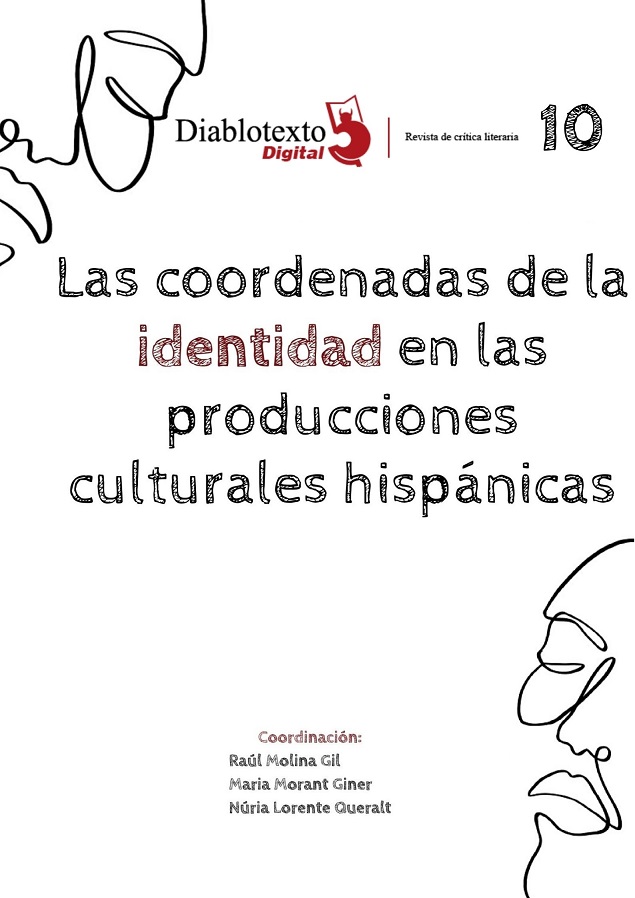Camilo José Cela's Café de artistas (1953) and the narratological disorder of the story: determinism and optimism
DOI:
https://doi.org/10.7203/diablotexto.10.21285Keywords:
Determinism, Optimism, Behaviourist realism, Narratological disruptions, Identity fragmentation Abstract
Abstract
Café de artistas was first published in number 6th of the collection Novela del Sábado, in 1953. It was a short novel of 64 pages that was modern in more than one sense. Even if the short novel seemed to be chaotic, the reader is able to clearly find the depiction of what goes on the lives of its characters. In this work my final aim is then to show how precisely it’s the lack of narrative order which entails the paradoxical view of Cela’s determinist society. I also want to show, semantically this time, how Cela opts for an optimistic result in this work of 1953.
 Downloads
Downloads
 References
References
Álamo Felices, Francisco (2021). “La ficcionalidad: las modalidades ficcionales”, Castilla. Estudios de literatura, n.º 3, pp. 299-325.
Aldecoa, Josefina (1983). Los niños de la guerra. Madrid: Anaya, Col. Tus libros.
Barthes, Roland, et al (1972). Análisis estructural del relato. Buenos Aires: Ciencias sociales.
Buckley, Ramón (1974). “Del realismo social al realismo dialéctico”, Ínsula, n.º 326, pp. 1-4.
Castellet, Josep María (1955). Notas sobre literatura española contemporánea. Barcelona: Laye.
Cela, Camilo José (1945). Pisando la dudosa luz del día. Poemas de una adolescencia cruel. Barcelona: Ediciones del Zodiaco.
Cela, Camilo José (1953). Café de artistas. Madrid: La Novela del Sábado.
Cela, Camilo José (1996). "Historia incompleta de unas páginas zarandeadas”, Papeles de Son Armadans, tomo XL, n.º 120, pp. 231-240.
Cela, Camilo José (1969). Café de artistas y otros cuentos. Madrid: Biblioteca Básica Salvat de Libros RTV.
Cela, Camilo José (1993). Memorias, entendimientos y voluntades. Barcelona: Plaza y Janés.
Cela, Camilo José (1999). Tobogán de hambrientos. Barcelona: Plaza y Janés.
Cruces Colado, Susana (2006). “Las traducciones de Camus en España durante el franquismo: difusión y censura”, Journal of Franco-Iberian Studies, n.º 2, pp. 82-113.
Díaz Arenas, Ángel (2017). De Pascual Duarte a Madera de boj, de Camilo José Cela. Catorce pasos hacia la modernización de la novela. Frankfurt: Peter Lang GmbH.
García Landa, José Ángel (1998). Acción, Relato, Discurso: Estructura de la ficción narrativa. Salamanca: Ediciones Universidad de Salamanca.
Genette, Gérard (1989). Figuras III. Barcelona: Lumen.
Henn, David (1990). “El pesimismo en la narrativa celiana”, Hispanística, n.º 8, pp. 53-68.
Ilie, Paul (1978). La novelística de Camilo José Cela. Madrid: Gredos.
Magallón Anaya, Mario (2013). “El problema del sujeto en la posmodernidad”, Bogotá, n.º 83, pp. 381-408.
Neira, Julio (2014). Memorial de disidencias. Vida y obra de José Manuel Caballero Bonald. Sevilla: Fundación José Manuel Lara.
Sobejano Esteve, Gonzalo (1978). “La colmena: olor a miseria”, Cuadernos Hispanoamericanos, n.º 337-338, pp. 113-126.
Torrente Ballester, Gonzalo y Josep María Castellet (1980). “La colmena”. En Rico, Francisco (Dir.), Historia y crítica de la literatura española. Época contemporánea: 1939-1980, Barcelona: Crítica
Torres, Sagrario (1978). “El otro Cela”, Cuadernos Hispanoamericanos, n.º 337-338, pp. 272-288.
Downloads
Published
How to Cite
-
Abstract861
-
PDF (Español)707
Issue
Section
License
Licencia de reconocimiento de Creative Commons “Reconocimiento - No Comercia l- Sin Obra Derivada
Authors who publish with this journal agree to the following items:
The authors will keep their copyright and guarantee the journal the right of first publication of their work, which will be simultaneously subject to the Creative Commons license that allows third parties to share the work indicating its author and its first publication in the journal. The authors may adopt other non-exclusive license agreements to distribute the version of the published work (e.g., depositing it in an institutional telematic file or publishing it in a monographic volume), with an acknowledgment of its initial publication in this journal. The authors are allowed and encouraged to disseminate their work through the Internet (e.g., in institutional telematic archives or on their website) before and during the submission process, which can produce interesting exchanges and increase citations of the published work. (See Effect of Open Access)




